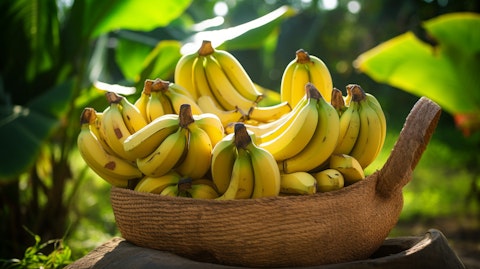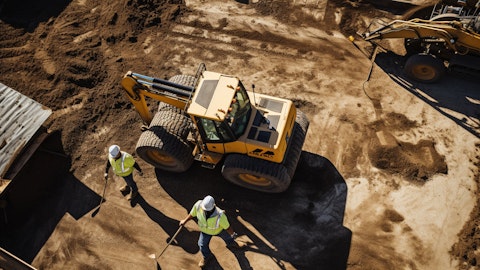Fresh Del Monte Produce Inc. (NYSE:FDP) Q2 2025 Earnings Call Transcript July 30, 2025
Fresh Del Monte Produce Inc. beats earnings expectations. Reported EPS is $1.18, expectations were $0.66.
Operator: Good day, everyone, and welcome to Fresh Del Monte Produce’s Second Quarter 2025 Earnings Conference Call. Today’s conference call is being broadcast live over the Internet and is also being recorded for playback purposes. [Operator Instructions] For opening remarks and introductions, I would like to turn today’s call over to the Vice President, Investor Relations with Fresh Del Monte Produce, Ms. Christine Cannella. Please go ahead, Ms. Cannella.
Christine Cannella: Thank you, Deseray. Good day, everyone, and thank you for joining our second quarter 2025 conference call. Joining me in today’s discussion are Mr. Mohammad Abu-Ghazaleh, Chairman and Chief Executive Officer; and Ms. Monica Vicente, Senior Vice President and Chief Financial Officer. I hope that you had a chance to review the press release that was issued earlier via Business Wire. You may also visit the company’s IR website at investorrelations.freshdelmonte.com to access today’s earnings material and to register for future distribution. This conference call is being webcast live on our website and will be available for replay after this call. Please note that our press release and our call today include non-GAAP measures.

Reconciliations of these non-GAAP financial measures are set forth in the press release and earnings presentation, which is available on our website. I would like to remind you that much of the information we will be speaking to today, including the answers we give in response to your questions, may include forward-looking statements within the safe harbor provisions of the federal securities laws. In today’s press release and in our SEC filings, we detail risks that may cause our future results to differ materially from these forward-looking statements. Our statements are as of today, July 30, and we have no obligation to update any forward-looking statement we may make. During the call, we will provide a business update, along with an overview of our second quarter 2025 financial results, followed by a question-and-answer session.
With that, I will turn today’s call over to Mr. Mohammad Abu-Ghazaleh. Please go ahead.
Mohammad Abu-Ghazaleh: Thank you, Christine, and thank you for joining us for our second quarter 2025 earnings call. The second quarter of 2025 delivered another period of strong performance for Fresh Del Monte, continuing the momentum we have built through consistent execution and strategic discipline. This quarter, historically our strongest of the year, saw growth across key financial metrics. Net sales increased by 4%. Gross profit rose 6% compared with the prior year period, and gross margin expanded to 10.2% from 9.9% compared to the same period last year. This quarter’s positive results reflect the power of consistency and continuous improvement across our fresh-cut business and ongoing demand for our pineapple portfolio.
Q&A Session
Follow Fresh Del Monte Produce Inc (NYSE:FDP)
Follow Fresh Del Monte Produce Inc (NYSE:FDP)
Receive real-time insider trading and news alerts
Much of this growth reflects a long-term shift in the pineapple category, one, we helped lead. In the 1970s, Americans consumed less than a pound of pineapple per day per person. Today, that number is nearly 8x higher according to the USDA. This transformation began with our 1996 launch of Del Monte Gold, the first widely available sweet pineapple and continues through the strength of our proprietary offerings and value-added formats. We know that consumers are engaging more with pineapples. According to [indiscernible] panel, a leading provider of free in-house for purchase insights, consumer spend on tropical fruit has risen 58% since 2017, outpacing overall produce growth and signaling the rising relevance of the category itself. As a pioneer in this space, we are well positioned to lead.
Demand for our pineapple portfolio remains strong and continues to outpace supply, driven by trusted brands like Honeyglow and Pinkglow, which is the result of the case of agronomic leadership and targeted investments. We are managing global supply carefully, strengthening continuity and taking steps to ensure consistent availability for our customers. We also launched Pinkglow in the United Arab Emirates during the quarter, marking our first sustained market entry for a variety in the Middle East. While still early in scale, it reflects a strategic step in expanding our high-value portfolio into new international markets where brand distinction and [indiscernible] potential alike. We also know that when it comes to pineapples, convenience matters.
Demand accelerates when the product is fresh cut, prepared and ready to enjoy. As more consumers around the world prioritize health, flavor and ease, our ability to meet that demand with the right product mix and the operational agility to deliver it is driving meaningful growth across our fresh-cut business. We are also continuing to advance our efforts in high-margin, value-added business ventures, particularly those focused on residues and specialty ingredients. These projects are still in their early stages, but we believe they represent real long-term opportunities. Like many in the industry, we are managing disruptions at the Port of Caldera in Costa Rica. Unusually strong ocean swirls, the worst that we have seen in decades, have severely limited vessel access.
With minimal structural protection, the port has become a choke point, leading to wait times of 3 to 5 days and increased congestion. The result is higher cost and broader logistical impact across the industry. While the situation remains difficult, our teams are responding with urgency, adjusting schedules, reallocating shipments and doing everything possible to maintain continuity for our customers. Before I go, I believe it’s important to discuss an industry-wide situation regarding bananas, one that I have been predicting and warning about for years. There is a global shortage in banana production. The causes are clear, shifting climate patterns, particularly warmer temperatures combined with humidity are accelerating the spread of disease in key growing regions.
Primarily Black Sigatoka, on top of that, the continued spread of Fusarium wilt known as Tropical Race 4 is adding further pressure. These diseases are having a direct impact on supply. Black Sigatoka is affecting crops across Central America, while other countries are facing the compounded impact of both diseases. As we have shared previously, our R&D teams have been working to address the global threat posed by Fusarium wilt and we are pleased to report that field testing of TR4 resistant gene additive banana lines is expected to begin in the coming months, a meaningful step toward long-term category resilience. Meanwhile, global demand for bananas remains strong as they continue to be one of the most affordable and accessible fruits in the grocery aisle.
We are already seeing a clear imbalance between supply and demand, and we anticipate this would remain a key industry dynamic in the quarters ahead. With that, I will turn it over to Monica to discuss our second quarter 2025 results in detail. Monica?
Monica Vicente: Thank you, Mr. Abu-Ghazaleh, and good morning, everyone, and thank you for joining us on today’s call. I’ll begin with our second quarter financial results, followed by our outlook for the rest of the year. As Christine mentioned, our press release and our call today include non-GAAP measures. Reconciliations of these non-GAAP financial measures are set forth in the press release and earnings presentation, which is available on our website. The second quarter is historically our strongest period. Having said that, this quarter reflects our continued efforts to expand our margins by focusing on improving our product mix. Now let’s go through the financial results. Net sales were $1.183 billion compared with $1.14 billion in the prior year, an increase of 4%.
The increase was driven by higher net sales in our fresh and value-added products and banana segments due to higher per unit selling prices and favorable impact of fluctuations in exchange rates primarily related to euro, Japanese yen, British pound. The increase also reflects tariff-related price adjustments in North America. Gross profit for the second quarter was $120 million compared with $113 million in the prior year. The increase was driven by higher net sales in our fresh and value-added products segment, partially offset by higher per unit production and procurement costs as well as increased distribution costs, including tariff charges in North America. Gross margin was 10.2% compared with 9.9% in the prior year. This also includes a sequential increase from 8.4% in the first quarter.
Operating income for the second quarter was $68 million, roughly in line with the prior year. The slight increase was primarily driven by higher gross profit, partially offset by lower gain on disposal of property, plant and equipment in the current year. Adjusted operating income was $69 million compared with $65 million last year. Other income for the second quarter was a gain of $6 million compared with a gain of $2 million in the prior year. The change was due to equity earnings from unconsolidated companies within the food and nutrition sector. Net income attributable to Fresh Del Monte for the second quarter was $57 million compared with $54 million in the prior year, and adjusted FDP net income was $59 million compared with $51 million last year.
Our diluted earnings per share for the second quarter was $1.18 compared with $1.12 in the prior year. And adjusted diluted earnings per share was $1.23 compared with $1.06 in the prior year. Adjusted EBITDA for the second quarter was $95 million, up from $89 million in the prior year. Both quarters reflected an 8% margin as a percentage of net sales. Let’s now take a closer look at the financial performance for the second quarter across our business segments beginning with our fresh and value-added product segment. Net sales for the second quarter were $723 million compared with $694 million last year, an increase of 4%. The increase was primarily driven by higher per unit selling prices in our pineapple product line as well as higher sales volume and per unit selling prices in our fresh-cut fruit product line, both supported by continued strong market demand.
Additional contributions came from the favorable impact of fluctuations in exchange rates as well as tariff-related price adjustments in North America. The gains were partially offset by lower net sales in our fresh-cut vegetable and vegetable product lines, reflecting strategic operational reductions implemented in the fourth quarter of 2024, which included the sale of certain assets of Fresh Leaf Farms. Gross profit was $85 million compared with $78 million in the prior year. The increase was driven by higher net sales, partially offset by higher per unit production and procurement costs as well as increased distribution costs, including the impact of tariffs in North America. Gross margin was 11.7% in the second quarter compared with 11.2% in the prior year.
This also includes a sequential improvement from 10.1% in the first quarter of this year. We are continuing to build on this momentum as we work toward our goal of sustaining double-digit gross margins in the long teens for this segment, supported by ongoing improvements in product mix, including growth in our premium pineapple varieties such as Honeyglow and Jet Fresh. Moving on to Banana segment. Net sales for the second quarter were $410 million compared with $394 million in the prior year, an increase of 4%. The increase was primarily driven by higher per unit selling prices across each of our regions, combined with favorable impact of fluctuations in exchange rates, along with tariff-related price adjustments in North America. We also saw higher sales volume in the Middle East as last year was impacted by shipment disruptions related to the Red Sea conflict.
The increase was partially offset by lower sales volume in Asia where an oversupply of local seasonal fruit weakened demand and persistent crop disease reduced available supply. In North America, sales volume was also impacted by crop disease, specifically the continued spread of Black Sigatoka, which has intensified by adverse weather conditions in our growing regions. Gross profit was $30 million, in line with the prior year. The benefit of higher net sales was mostly offset by higher per unit production and procurement costs resulting from the adverse weather conditions already mentioned, along with higher distribution costs, including the impact of tariff-related charges in North America and ongoing industry-wide port congestion and logistical disruptions across our Central American ports.
Gross margin was 7.3% in the second quarter of 2025 compared with 7.6% in the prior year. Lastly, our Other Products and Service segment. Net sales for the second quarter were $50 million compared with $51 million in the prior year. The slight decrease was primarily due to lower per unit selling prices in our poultry and meats business. Gross profit was $5 million compared with $6 million in the prior year as a result of the lower net sales. Gross margin was 10.4% in the second quarter compared with 10.7% last year. Now moving to selected financial results. Our income tax provision for the second quarter was $14 million compared with $12 million in the prior year. The increase was primarily due to increased earnings in certain higher tax jurisdictions.
Our effective tax rate for the second quarter was 20%. Net cash provided by operating activities for the 6 months was $159 million compared with $144 million in the prior year. The increase was primarily due to higher net income and working capital fluctuations, mainly driven by higher levels of accounts payable and accrued expenses, partially offset by higher levels of inventory when compared to the prior year. We ended the second quarter with $201 million of long-term debt, an $84 million or 29% reduction compared with the prior year and an 18% reduction compared with fiscal year-end 2024. Our adjusted leverage ratio remains at less than 1x EBITDA. Our CapEx investment for the first 6 months was $22 million compared with $21 million in the prior year.
As announced in our press release, we declared a quarterly cash dividend of $0.30 per share payable on September 5, 2025, to shareholders of record on August 13, 2025. On an annualized basis, this equates to $1.20 per share, representing a dividend yield of 3.3% based on our current share price. With that, let’s turn to our full year outlook and strategic priorities. As we look ahead, we continue to expect full year 2025 to be broadly in line with the outlook we shared during our first quarter call. Our outlook reflects our expectation for stable demand across our core products, ongoing operational efficiencies and disciplined execution on our strategic initiatives. As part of that execution, we’re currently transitioning from legacy break bulk shipping vessels to container vessels in the Asia Pacific region and we plan to sell two older vessels later this year.
This shift enhances operational efficiency and better aligns with our evolving logistic needs. As I mentioned earlier, historically, the second quarter has been one of our strongest and this year was no exception. We are confident about our full year trajectory while we remain mindful of evolving external factors beyond our control. We believe our underlying business fundamentals are strong, and we are confident in our ability to deliver on our full year 2025 objectives. We reiterate our expectation for the full year as follows: We expect to see net sales growth 2% year-over-year. And as far as gross margins by business segment, in our fresh and value-added products segment, gross margin is expected to be in the range of 10% to 11%. In our Banana segment, gross margin is expected to be in the lower end of historical range of 5% to 7%.
For our Other Products and Service segment, gross margin is expected to be in the range of 12% to 14%. Our selling, general and administrative expense is expected to be in the range of $205 million to $210 million. As it relates to CapEx, we now expect our full year spend to be in the range of $70 million to $80 million, down from $80 million to $90 million previously communicated. This revision reflects updated project execution time lines. We remain committed to funding initiatives that drive long-term value. We expect noncash provided by operating activities to be in the range of $180 million to $190 million. In closing, the second quarter delivered solid net sales and net income, consistent with our expectations and relative — and reflective of the seasonal strength we typically see this time of year.
As we enter the second half, we’re mindful of typical third quarter dynamics including increased availability of seasonal fruit and softer demand during the summer months. We remain focused on executing our strategy, delivering value and positioning Fresh Del Monte for long-term success. This concludes our financial review. We can now turn the call over to Q&A. Desaray?
Operator: [Operator Instructions] And we have a question comes from the line of Mitch Pinheiro with Sturdivant & Company.
Mitchell Brad Pinheiro: So I did — I want to start — I have a bunch of questions. First on the pineapple business. So pineapple supply has struggled a little bit here, I guess, weather-related, but I was wondering, Mohammad, if you could give us an update on where you think and how — we saw a lot of new pineapple growth, and I was wondering how you expect that to play out over the next 6 months and then what supply looks like for your pineapples into 2026? So are we going to see an increase at best? Or are we not there yet in the cycle?
Mohammad Abu-Ghazaleh: We expect that continuing on to the end of this year and going into next year, there will be — in our opinion, there will be a shortage of supply, more or less like this year or a little bit even more. So we expect from our part — on our side, I can’t speak for the industry, but as Fresh Del Monte, we see a very strong pineapple market going forward, especially with our premium varieties that is unparalleled in the market. And our expertise and our seeds are definitely better than anything in the market. So I believe that in our case, I don’t see any change to what is going on right now. The dynamics in the market through ’26 and in addition to that, and I would say, about a couple of years, 2, 3 years, we will be starting our production in Brazil, which I think we haven’t announced that, but that will be another new area of production sourcing. And that would be mainly for the Brazilian market in particular.
Mitchell Brad Pinheiro: So once you get through 2026, I guess, like what type of growth rate would you expect to see in your own businesses supply? Like are we talking new planning and things like that would be mid-single digit? I mean, are you — is it stronger…
Mohammad Abu-Ghazaleh: I would say in Costa Rica, we will have expansion. As we see, we are expanding our production. Areas that have not been planted before already under plantation. And as I said, we are expanding also in other parts of the world and in Africa and Brazil as well as in the Philippines. So we are having, I mean, not concentrated in one location, but really across the world, but we will be having over the next 2 to 3 years. I cannot give you figures exactly, but I’m telling you that we are already expanding our production capacity, and we expect there will be. And I would say it will not be like 20 million boxes additional, but there will be a meaningful increase in our production in the next 2 to 3 years.
Monica Vicente: And Mitch, on the Costa Rica expansion, specifically, a little bit higher than the mid-single digits, and you know this is a long-term crop. So definitely ’27 from today compared to ’27 little bit higher than the mid-single digits, just Costa Rica.
Mitchell Brad Pinheiro: Okay. And then regarding Pinkglow, I’m seeing more distribution. Where do you guys stand in terms of like let’s just talk about the U.S. market or North America, your ACV, does — where is it today? How supply constrained is it? And what do you see the future as far as distribution growth for the Pinkglow in the next, say, year, 2 years?
Mohammad Abu-Ghazaleh: Actually, we were constrained by limited supply going to the market because until recently, the authorities in Costa Rica were not allowing us to plant more big pineapple because of the GMO issue and the contamination risk. We have been granted recently to increase our acreage, and that’s what we are going to be doing very soon. So supply is — hopefully, it will take about 18 months for supplies to start coming in, additional supplies, I mean. So I will see — I would not say in — could be at the end of ’26, early ’27, we will see more suppliers coming into the market, where the market is really absorption or the reception is there. It is that we don’t have enough supply along with the other countries that we are not supplying yet, I mean, outside North America, which is, as we said, we’ve just been sending some pink pineapple by air to the Emirates, just to give you — I mean it’s being sold online as well.
I mean it’s not in the supermarkets. And just to give you an idea of — it’s about — I would say, about $30, $33 a piece that is being sold now online in the Emirates. And everything that we send is prebooked and presold. So we are now trying to get into Saudi Arabia as well and a couple of other countries in the region. But as I said, also supply is a constraint. But we will evaluate which market pays more, so we allocate where the money is.
Mitchell Brad Pinheiro: It’s quite an accomplishment. Like, I mean, your — this Pinkglow just sells out everywhere I go. And when I talk to the produce manager, it’s — they sell every one they can get and would like more. So it’s a good situation for you guys, and they’re selling at double-digit prices per pineapple, which is incredible, so anyway.
Mohammad Abu-Ghazaleh: Yes. I mean, in addition to that, Mitch, we used to have a lot of residues from the pink pineapple that we could not export as export quality. And we did — and we didn’t have the opportunity because we didn’t have the authorization from the Costa Rican authorities to turn them into juice or to frozen, let’s say, IQF product. Thank god, recently for — in the last 2 months, we have been granted to freeze or to use this as frozen, and we are processing this, and this is great also addition to our SKUs. Pink also going into ice cream and juices through the food service industrial, I would say, segment.
Mitchell Brad Pinheiro: Changing the subject, moving to fresh-cut fruit. You’re doing very well on fresh cut fruit, obviously. Where specifically, is the demand coming from? Is it retail versus food service? Is it equal across the board? Is there any one geography that’s growing particularly strong for you guys? Can you talk a little bit about where that growth and demand is coming from and where you see it going?
Mohammad Abu-Ghazaleh: We see the demand mainly on the retail side. The biggest increase and expansion is on the retail side and the convenience stores. That’s where we see the biggest advances as well as — I mean, we are not talking only in North America, but we are having the U.K., we are having the Middle East region as well. So expansion and growth is actually across the world. And as we speak, we are looking at different countries, new countries to initiate also fresh-cut operations based on feasibility and return on capital, but that’s the way going forward. It’s not only in North America, but it’s a global expansion. With our expertise, know-how and the vertical integration, supply chain where we have the fruit and the ability to supply each region closer to the markets, the Fresh Del Monte advantage is that it is — it’s not only in one continent.
It’s not only produced in Costa Rica, let’s say, pineapple, which is the major SKUs in the fresh-cut, we produce it in three different — four different continents. So we are much closer to the markets logistically rather than just shipping it all the way from Costa Rica to, let’s say, to Japan or Costa Rica to Europe. I mean, we have Africa, which is closer. We play with logistics more than just the sourcing.
Mitchell Brad Pinheiro: Okay. And then — and your margins continue to march forward there as you leverage your capacity investments. Is that something — I mean, we should — where do you see the top end of like…
Mohammad Abu-Ghazaleh: You mean on the fresh cut?
Mitchell Brad Pinheiro: Yes.
Mohammad Abu-Ghazaleh: The fresh cut, I think the margins would stay more or less in the same region that we see right now. What would be our niche is that we will be introducing more innovation. I mean, let’s take guacamole, for instance, fresh guacamole. I mean, we started this almost probably a year or less than a year ago. And we see more than double-digit growth month-over-month, I mean, in that category. And we are the only one in the market that can produce fresh guacamole to the retail sector. So that gives you an idea where we are going. I mean, that’s the type of products that we — and type of SKUs that we would like to introduce and not just depend on the traditional type of fruit offerings or vegetables.
Mitchell Brad Pinheiro: Moving to Banana. I — how — in your view, the Black Sigatoka, that — how much has that affected the banana supply in Costa Rica or in Central America? Is that — is it definitely showing up as a drag on supply?
Mohammad Abu-Ghazaleh: No. Well, I mean, Costa Rica alone is down over 20% in their export volume this year as we speak. And that tells you — and it’s mainly because of the Sigatoka disease as well as other issues in the soil and the climate and — so I don’t see that this is going away. This is getting worse as a matter of fact, as we speak. I mean it is a disease — that disease gets immunity and they — the disease transforms itself against the kind of chemical that is being used. And over time, that chemical doesn’t have any more efficacy for treatment. And unfortunately, in this space, there is only one supplier in the world that has this product and it’s becoming even so costly that it’s adding more cost to the per banana box because you have to apply more cycles and to do more applications, which costs you more money.
And still, I don’t think that there is a cure in my opinion, unless something kind of extraordinary. On our part, we are working on several fronts to find a solution to the Sigatoka. I cannot disclose at this time, but we are doing a lot of work now to find solutions for that.
Mitchell Brad Pinheiro: Okay. And then — but over time here with the banana supply affected negatively, I guess, should be good for prices. You should be able to get — I mean, bananas are obviously one of the lowest priced items in the grocery channel. There seems to be some headroom for you to raise prices to offset the supply limitations. Would you see it that way or…
Mohammad Abu-Ghazaleh: It’s actually not our — I mean it’s an industry, it’s a supplier’s issue. It’s not our issue that still — I mean, we are very much — we even have lowered our volumes over the last two years in order to maintain profitability and make sense of this business. But the problem is not with the — I believe the problem is with the existing suppliers that they don’t understand that going forward, they cannot survive with such pricing in the market.
Mitchell Brad Pinheiro: Just a couple of other quick questions. It was interesting, you’re selling two of your older vessels, as you switch over to — sort of the legacy to the container ships. Are you going to — would you consider buying two new ones like you have adding to the fleet? Or are you happy with your current setup and will sort of lease vessels or however, for your capacity?
Mohammad Abu-Ghazaleh: No. But what Monica mentioned actually is only for Asia. These two vessels were servicing Japan and Korea markets and that’s what we are replacing. We are selling off these ships and using container shipping line now to replace it. As far as North America, everything is also on the table. I mean, we are — we will do whatever is the best interest of the company, definitely.
Mitchell Brad Pinheiro: Okay. And I mean, are you pleased — I mean, are you happy with the way your purchase of those six vessels? Is that working out as expected? It seems to be…
Mohammad Abu-Ghazaleh: You can see our cash generation, I think that speaks for itself, Mitch. You look at our cash, I think.
Mitchell Brad Pinheiro: And then a couple of other things. You had a $6 million equity earnings from unconsolidated companies. Which companies are generating that type of profit for you?
Mohammad Abu-Ghazaleh: Well, actually, we have invested in several funds that are friendly funds that we have been very close with and these are companies that are in the food industry, let’s say. And I think we have made the right choices and we made the right investments. And I think that this is just a beginning. I think these are very successful — extremely successful companies that are already growing double digit as we speak. So we are very, very pleased with what we invested.
Mitchell Brad Pinheiro: Okay. And then last question was just what was the — I didn’t see the Q yet, but the foreign exchange impact on revenue and gross profit, was there any — can you give us those amounts you mentioned?
Monica Vicente: Yes. The euro obviously has been getting stronger, which helped us. We do have part of our sales hedged at a little bit lower rate, but it definitely helped. The British pound also was stronger. And the Japanese yen was stronger than last year, even though it’s kind of weakened a little bit now, but definitely, those three currencies helped our net sales, but the local selling prices in these markets were also very strong. So it was both scenarios.
Mohammad Abu-Ghazaleh: But to add to what Monica said that you have to think, there is a tailwind on one side, and we have headwinds on the other side. I mean, Costa Rica by itself is a very, very difficult situation. I mean we used to have Colón exchange rate to the dollar three years ago for CRC 610, CRC 620, and today, we are barely at around CRC 500, CRC 506, CRC 505, which you can say and increased, of course, inflation over the last 2, 3 years, continuous inflation, continuous increasing cost and then the exchange rate is getting stronger, and that’s huge headwinds for us. I mean, added a lot of cost on our production, be it on pineapple, melon or bananas or whatever we do there. So really, when you look at the tailwind, which is the euro or the [indiscernible] but you also have to look at the headwind, and then one offsets again to each other.
I wish the Colón would have been normal as it used to be, then it would have been even much better picture than what we see today.
Operator: [Operator Instructions] There are no further questions at this time. I would like to turn the call back over to Mr. Mohammad Abu- Ghazaleh for closing remarks.
Mohammad Abu-Ghazaleh: Thank you, Desaray, and I would like to thank everyone for joining us on this call today and hope to talk to you on our next quarter with equally good news. Thank you, and have a good day.
Operator: Ladies and gentlemen, that concludes today’s call. Thank you all for joining.
Follow Fresh Del Monte Produce Inc (NYSE:FDP)
Follow Fresh Del Monte Produce Inc (NYSE:FDP)
Receive real-time insider trading and news alerts





